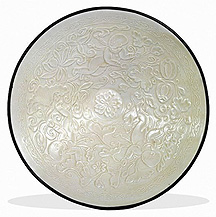
Ding ware, from Hebei province, northern China
Song dynasty (late 11th - early 12th century CE)
White porcelain with molded decoration
Diameter: 21.3 cm (rim)
Diameter: 4.2 cm (foot)
Bequeathed by Henry J. Oppenheim
Acquisition number: #OA 1947.7-12.62
Image courtesy of the British Museum (copyright reserved)
Ding wares were produced in Hebei province in northern China, and were considered one of the "five great wares" of the Song period (960-1279 CE). Ding bowls such as this were highly prized by the Song emperors, and from as early as 980 they were sent regularly to the court as a form of tribute.1
The earliest Ding wares were all incised and fired individually, a tremendously labor intensive process for the creation of a single piece. Later, the Ding craftsmen began pressing the unfired bowls into molds to generate uniform patterns, and to fire them in stacks, which allowed for an assembly-line type of mass production. Later impressions are often much less clear, due to deterioration of the molds after frequently reuse.2 For this reason, earlier impressions were more highly valued, just as they are by collectors today.
The example shown here is of the later molded type, and appears to be an early impression, due to the crispness of the design, which features children frolicking among lotus blossoms. The edge of the bowl is bound with a copper band that not only enhances pure white of the porcelain, but also conceals the untreated rim.3
(1) From the British Museum web page dedicated to this object.
(2) Ibid.
(3) Ibid.